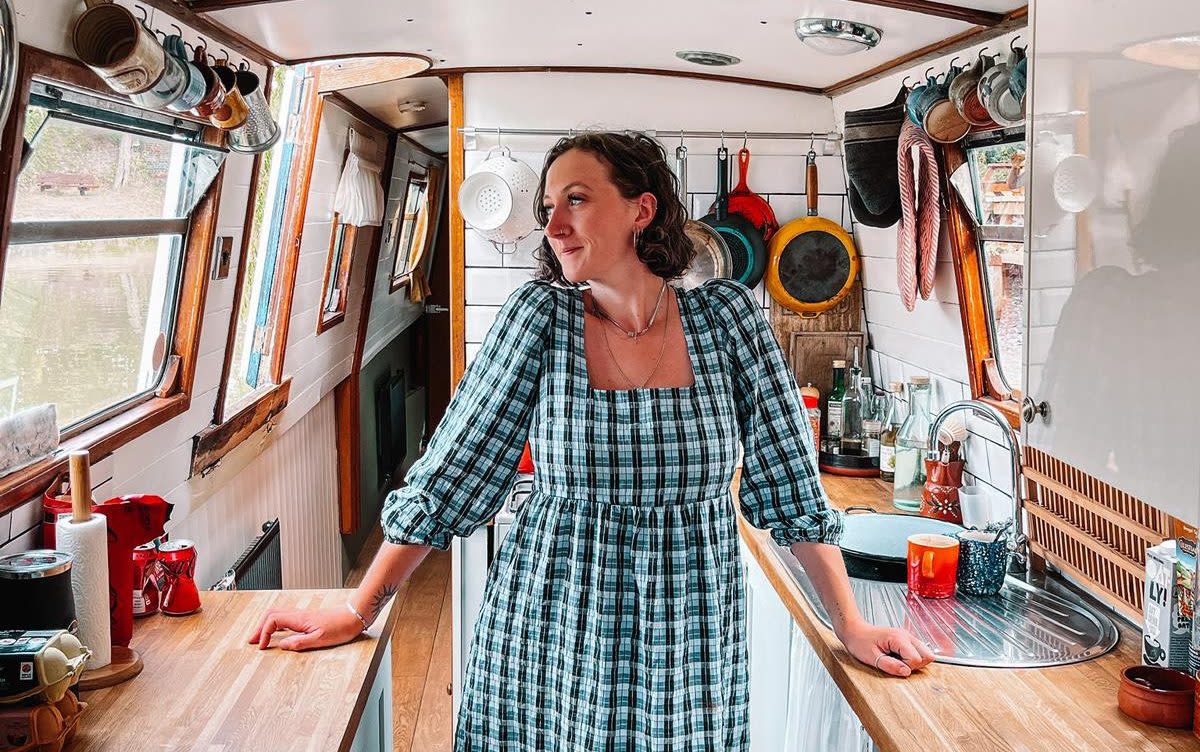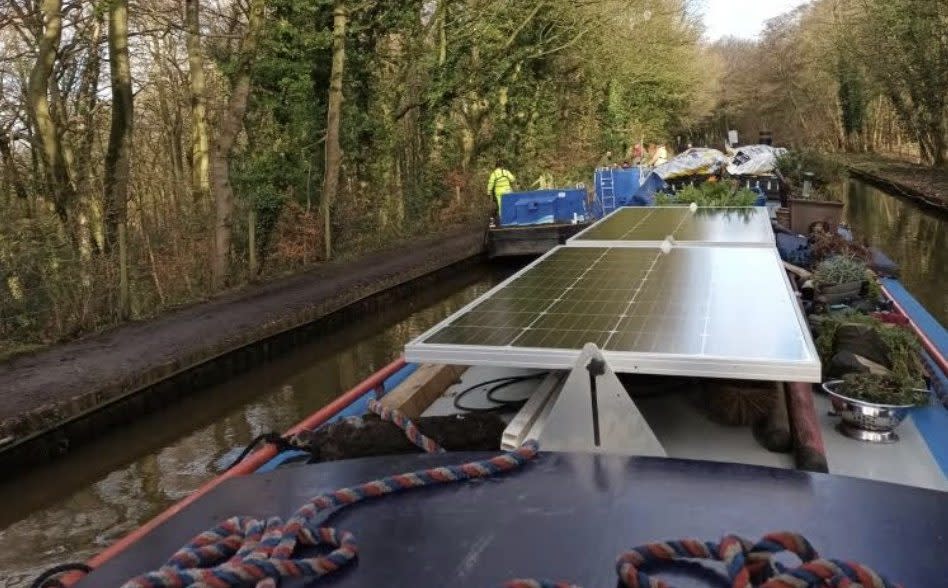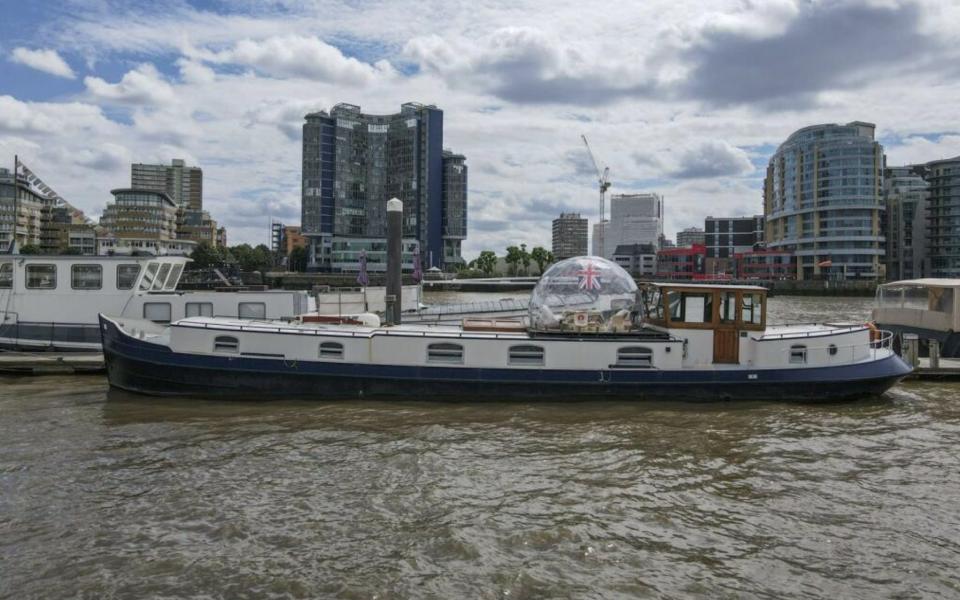‘I can’t tell you how much we got rid of’: The simplicity of life on the canals

Emily King started living on a canal boat eight years ago when she wasn’t able to find student halls as a first year student at Bath Spa University.
Now 26 and working full time as a recruiter, she and her husband Cameron are so enamoured of life on the water they are considering putting off having children in order to stay afloat.
“The plan is to stay on the boat until my parents want to live on it,” she says. “This boat is a bit snug for children. So we go around and around about whether we should stay on the boat or have kids.”
Emily says that when her parents retire on to the boat, she and Cameron may move into a house and buy their own boat later in life to enjoy with their own children one day.
For now, Taliesin – their 57ft narrow boat – is moored in Bath, but their summers are spent travelling around making the most of the freedom it gives.
Deena Ingham and her husband Steve’s move on to their narrowboat was also unplanned.
When they bought Preaux, their 34-year old boat christened after a village in northern France seemed a good fit.
“She had been in a marina most of her life, she hadn’t travelled,” says Deena of the boat.
However, the Covid pandemic changed their aspirations. Realising that as an academic and a landlord they could live and work from anywhere, Steve set about renovating the boat to make it liveable.
Three years later they now rent out their home and roam the UK’s waterways with little intention of returning to dry land.
“I can’t tell you how much we got rid of, so much stuff. We have what we need and most things double up,” Deena says.
They say they live by the Swedish principle of lagom roughly translating as “just the right amount”.
“Friends are unlikely to buy me a bottle of gin without buying me a candle to go in it after,” she says. “The sofa becomes a double bed, things like that. We live much more simply.”
So, could you do the same? Telegraph Money takes you through everything you need to consider before embarking on a life on Britain’s waterways.
What to consider before buying
Housing costs are rising, fast. Around 2.4 million homeowners face a financial shock as they come to the end of their fixed mortgage term before the end of 2024 according to banking trade body UK Finance.
Strong demand for properties and rising costs for landlords mean rents are also increasing. Could the waterways be the answer to reducing your costs?
There are currently around 35,000 licences granted to boats in the UK by the Canal & River Trust, which administers most of the UK’s waterways. The licence allows you to make use of the 2,000 km of waterway owned by the Trust. Of these a fifth are permanent residences, this proportion has remained flat for a decade.
Do you need a loan?
Like houses, there is a huge range of boats on the market. The average price of a narrowboat is £57,000 according to specialist website Boats and Outboard, although some can cost over £150,000 (for comparison, the average price of a house in England is currently £310,000 according to the Land Registry).
There are plenty of options for places to buy from and an active secondhand market to consider. However, unless you have around £60,000 you are happy to commit, it is likely you will need some financing to help fund your purchase.
When Emily found herself without student accommodation, it was fortunate that her parents had considered buying a boat in their retirement and the predicament provided an opportunity to invest.
They opted to fund the initial purchase of a smaller 35-foot boat with their savings and then used the sale to upgrade to the one they own now.

Deena and her husband bought their boat for £25,000 in the summer of 2018 – then invested £9,000 immediately to replace the hull and get the boat through the Boat Safety Scheme, a charity. They funded the investment using savings and cashing in a private pension.
However, for others it may not be as simple.
The good news is that it is possible to get a loan, similar to a mortgage, to help you buy a property. For this you will need to go to a specialist lender and they are likely to have similar requirements to a traditional mortgage provider such as access to your credit history and evidence of your income.
There may also be different requests for information depending on the type of boat you are looking to buy and how it will be used. Although unlike a mortgage, any borrowing does not necessarily have to be secured against the boat itself.
Andy Wood, of Swanley Brokerage, says: “The market for lenders providing finance for residential boats is very limited. I believe there are just two or three. The big lenders tend to lend against commercial vessels these days.”
Like home loans, interest rates for residential boats do vary. The least expensive is about 12pc, staggeringly high compared to conventional mortgages, and the most expensive is about 18pc.
These vary in part depending on what features they offer. Those with higher rates will typically not have an early settlement penalty, for instance.
“Taking on debt to buy a residential boat has increased in popularity over the last couple of years,” says Wood.
Buyers can also take out a personal loan to make the purchase. Currently interest rates on that type of borrowing are between 8pc and 9pc for a five year loan term, according to data supplied by analyst MoneyFacts.
What paperwork do you need to fill out?
Once you are close to buying a boat there are licences and permits that are required.
The first one you need to look at is a Boat Safety Scheme certificate, which works similar to an MOT. It is a requirement for all boats on Canal and River Trust waterways, as well as those owned by the Environment Agency, regardless of whether they are permanent residences or not.
The second important document you need is a waterway licence granting you access to the canals and rivers of the UK. A gold licence lets you navigate on all waterways owned by both the Canal and Rivers Trust and the Environment Agency and runs for a year.
Currently the average cost for a gold licence is around £1,400. However, the Canal and Rivers trust is increasing the price of its licences. The organisation sent a letter to members confirming that it will put up the price in line with November’s inflation figures with the changes taking effect from April 2024.
There are additional licences for the Norfolk and Suffolk Broads and Scottish waterways among others. There are some discounts available, for example for electric boats. Whether the price rises dents boaters’ enthusiasm for the waterways remains to be seen. The Trust says the increase is to make up for the loss of government funding.
“I fear some people will stop paying their licence and I would like to see what the Trust has factored in for that happening,” says Deena.
“We already see a lot of unregistered boats, mainly those not travelling very far, and the Trust is struggling to deal with non-payers and abandoned boats.”
However, if you aren’t intending to cruise and will be moored instead this comes with its own costs. You will need a long-term or waterside mooring if you intend to stay at one location and it is managed by the Trust.
Private locations may still require a licence from the trust depending on its relationship to the nearest public waterway.
Recommended
Phil Spencer: My worst property mistakes – and how you can avoid them
How often do you need to move? And what about mooring costs?
Staying in one location requires a permanent mooring. Moorings are charged per foot, so if you have a bigger boat you will end up paying more. The cost is also based on demand in the area and the facilities that come with the mooring.
For example, at Cadogan Pier in Chelsea, London, a 14.63m boat (47 feet) currently has an estimated annual mooring cost of £14,500.
While the Chelsea Reach Boat Owners’ Association says the average cost of a mooring at Chelsea Reach is £236 per foot per annum for those without a fixed-term licence and £138 per foot a year for those with licence.

However, a mooring on private farmland without any facilities may only cost £15 per foot a year, making the comparative total annual price just £810.
In Bath, Emily and Cameron pay £7,400 a year to moor close to the city. The location allows her husband to work in Bath as a building surveyor, as he wouldn’t have access to the same opportunities in a more rural location.
Even if you are continually cruising you will need a waterside mooring for overnights or stop-offs.
Most of the places you can stop along the waterways are clearly marked with the length of time you can stay for free, usually for between four hours and 14 days – the waterways limit on a one term stay without a permanent residence.
For Deena and Steve, cruising is one of the main appeals of the lifestyle.
“This week alone we have been moored near Lincoln, Newark, Nottingham. We have moored in the middle of nowhere with nothing around us and that diversity and excitement of never quite knowing what you’ll find is wonderful.”
However, if moving during the colder months doesn’t sound appealing the Canal and Rivers Trust offers permits for winter moorings – longer stints of up to four months in the same place over the colder period. Charges for the moorings are in bands based on the site itself.
More generally, prices for moorings vary based on where you are situated and there is no national list of all prices.
While there are obvious benefits to a permanent mooring such as having a residential address, it comes with some disadvantages.
Unlike boats that constantly cruise, having a permanent mooring address means you will need to pay council tax.
Now you’ve sorted the boat, how do you get it moving?
Although electric canal boats are widely available, diesel is still the most popular fuel.
How much fuel you use will depend on the size of your boat, how much you move and the size of the boat’s tank – although they are usually around 200 litres.
As with all fuel the cost fluctuates, but Deena says on average they pay £1.10 a litre for diesel and that works out at around £13.50 per week.
Shepperton Marina currently quotes £1.54 per litre, for instance, although in some instances marinas are known to be more expensive than other sellers. You will also need to think about where you buy your supply and plan accordingly when you’re on the move.
Many boat owners use more than once source of power. Solar panels are an increasingly popular option for propelling and powering boats; as an estimate you need 100 watts for every 10 feet of boat.
“We mainly use our solar panels which have 800 watts of power which is more than enough. For using the washing machine we have a shoreline hook up in the marina which is paid for on pay-as-you-go cards,” says Emily.

Costs vary but they roughly start at £70 for a small panel generating 30 watts. This means you could be spending up to £1,000, depending on how much power you need.
It is worth having another option beyond solar for the darker parts of the year, especially if you expect to continue cruising.
Deena and Steve installed two 175-watt solar panels over two years ago costing £530 to install. As a result they save roughly £7.71 a week in diesel and in total they have saved about £1,000.
Another important consideration is how you get electricity on the boat for cooking and refrigeration, as well as any extra devices such as a laptop. There are three main ways to get power: a built-in generator, an engine-driven generator and batteries.
Once you are moored at a marina you are likely to be able to plug your boat into the mains and run your devices and systems that way.
Canal Junction, a website for narrowboat owners, estimates the total cost of providing power to a boat is between £1,000 to £3,000 a year.
Heating and water systems
There is also the question of how you run and heat your boat. Narrowboats have traditionally come with a multi-fuel stove used for heating that can burn both wood and coal. However, many modern boats now have central heating systems fuelled by diesel or liquefied bottled gas.
A diesel heating system costs around £200 a year for maintenance plus any additional parts. All heating systems need to be assessed yearly to ensure they work safely.
“We use about a tonne of coal a year on the fire. At some point we should convert the stove to a diesel one but we haven’t got round to it yet,” says Deena.
Last year they bought that amount for £600 and stored it at a relative’s house. They are yet to run out. As well as coal she and her husband collect firewood as they go to add to the stove.
Canal boat owners are now also entitled to government energy support schemes. They were initially left out because they do not use electricity meters, but payments are now being made – albeit with delays.
Correctly installed smoke, carbon monoxide and CO2 alarms are part of all boat safety examinations. All three range in price from around £20 at the low-cost end of the market, to hundreds of pounds at the top end.

The other important consideration is running a water and sanitation system. The simplest way of getting fresh water is collecting it from canal-side taps in tanks and cleaning it to make it safe for use.
Filtering and iodine are popular ways to clean water, although neither are without their downsides.
If you are planning to live aboard your boat a better option is a fully installed water system. Chlorine or hydrogen peroxide are reliable methods to clean inbuilt water systems on boats.
You can also use an instant gas water heater for a supply of hot water. Other options include a calorifier that uses an external source such as excess hot water from an engine cooling system, or diesel powered heating.
Then there is the smelly but vital question of toilets. Some narrow boats have integral sewage thanks that will need emptying via facilities in marinas. However, not all have them so if you are cruising it’s important you know where your next stop is. It’ll cost roughly £15-20 each time.
There is also the option of a self-pump out kit. These cost around £400 and allow you to empty the waste yourself into a sanitation station.
It may all sound like a faff but for some the systems and routine you need in place is part of the charm.
“I love the quirks of having to fill up your water and having to do all those things you don’t have to do in a house,” says Emily.
What are the other associated costs?
Having a permanent mooring means you also have a permanent address and as a result will have to pay council tax. Whereas continual cruisers are exempt from the cost.
While having a permanent address makes it easier to receive post and maintain bank accounts, many cruising boaters rent a PO Box for post or rent a postal address for around £25 a month.
The final two big costs with a narrowboat are maintenance and insurance.
Maintenance costs will differ depending on the age and usage of the boat, as well as the sophistication of your overall set up.
However, there are a couple of essentials. Engine checks and repairs cost roughly £100-250 a year, and it is advisable to black the hull with paint – to protect it and extend its life – every two and a half years.

This costs around £200 if you are doing it yourself, plus you may need to factor in paint, preparation costs and a place to take the boat out of the water.
On average Deena says they spend around £1,000 a year maintaining, investing and upgrading their boat including new appliances such as a fridge and washing machine.
Having the right insurance for your boat is essential as it is a condition of being granted a Canals and Rivers Trust licence. Canal boat insurance can usually be tailored to your specifications as insurers are aware of the range of boats and circumstances within the market.
The cheapest deals can be as low as a few hundred pounds a year but the costs begin to rise once you add specifics such as cover in the event of a fire or contents insurance.
There are no shortage of considerations when weighing up moving to a canal boat, adventure, it turns out, comes with admin.
It is also worth thinking about the emotional toll moving to a smaller space, either alone or with company, will take.
“To anyone thinking of doing it I recommend doing a long term hire so that gives you a feel for it. It can also help you decide what sort of boat you may want,” advises Deena.
“There are people who love it and there are people who loathe it. I remember my sister asking if we had killed each other yet. I enjoy telling her, no… not yet.”
Recommended
‘We spent £45k on a dilapidated beach hut – it’s a bulletproof investment’
